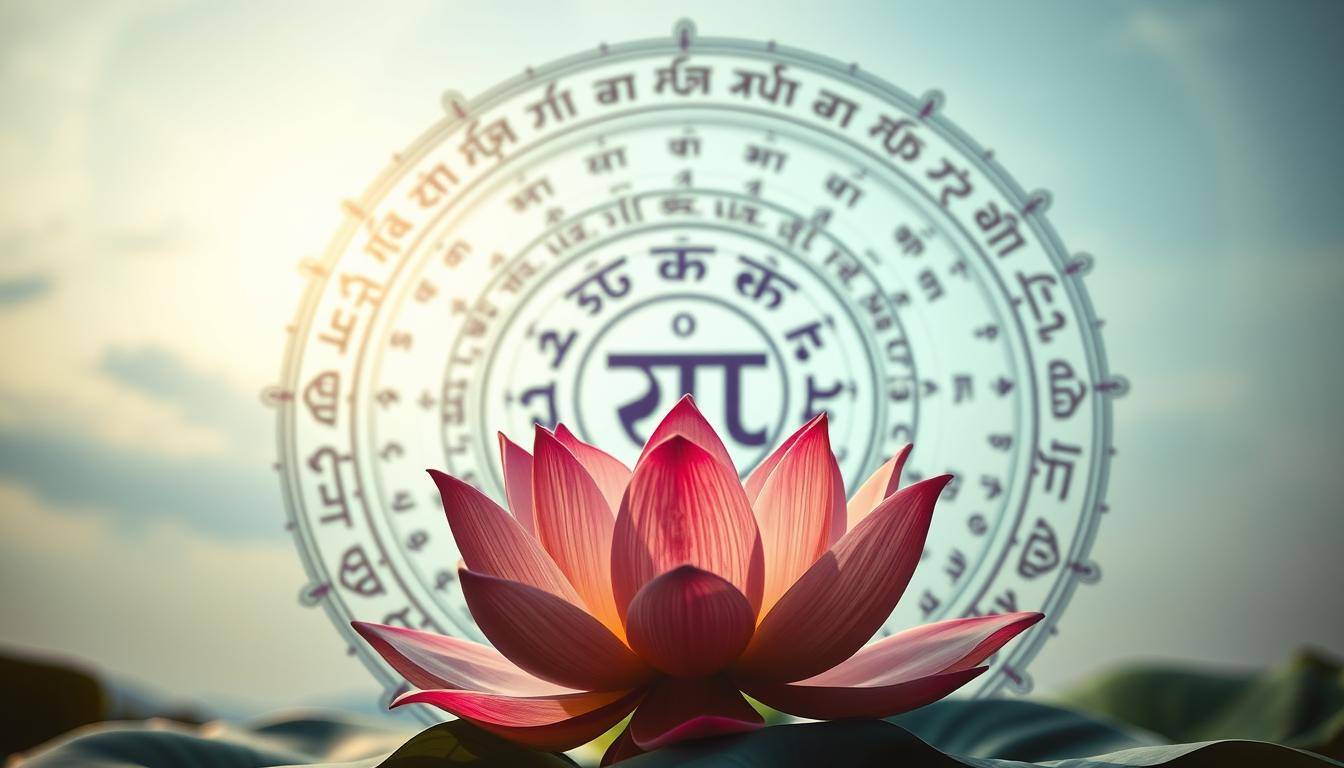“You must learn to let go. Release the stress. You were never in control anyway.” – Steve Maraboli’s words echo a truth recognized across cultures: true power lies in mastering emotional steadiness. This timeless skill finds its deepest roots in ancient Sanskrit philosophy.
The Latin term aequanimitatem – meaning “evenness of mind” – shares striking parallels with Eastern concepts. Sanskrit uses two profound words: Samatva (Hindu tradition) and Upekṣā (Buddhist practice). Both describe a balanced state where challenges don’t dictate reactions.
Why does this 2,500-year-old idea matter today? Modern neuroscience confirms what sages taught: mental clarity thrives when we observe emotions without attachment. The Sanskrit terms offer more than definitions – they provide actionable frameworks for navigating stress, relationships, and self-doubt.
By exploring these linguistic bridges, you’ll discover how to transform theoretical wisdom into daily resilience. This isn’t about suppressing feelings, but cultivating a centered awareness that outlasts temporary storms.
Key Takeaways
- The English word “equanimity” shares roots with Latin terms for mental balance
- Sanskrit philosophy uses two distinct terms: Samatva (Hindu) and Upekṣā (Buddhist)
- Ancient concepts align with modern psychology’s stress-management strategies
- Cultural wisdom traditions agree on emotional regulation’s importance
- Practical applications include improved decision-making and emotional resilience
Introduction to Equanimity

Mental steadiness acts as an anchor in life’s storms—not by denying waves of feeling, but by maintaining perspective amid turbulence. This quality, often called equanimity, represents conscious engagement with reality rather than passive endurance.
Defining Equanimity and Its Relevance
True balance isn’t about ignoring difficult emotions or forcing positivity. It’s a state of alert calmness where you observe experiences without being swept away. Think of it as watching clouds pass—you acknowledge their presence without becoming the storm.
Modern psychology validates this approach. Studies show that non-reactive awareness reduces stress hormones and improves decision-making. Unlike suppression—which bottles up feelings—or indifference—which creates detachment—this practice fosters genuine resilience.
User Intent and Informational Context
Why does this concept resonate today? 45% of Americans report chronic stress, according to the American Psychological Association. People seek tools to handle overwhelm while staying engaged with life.
This skill matters because it transforms how you experience challenges. Instead of reacting impulsively, you can respond with clarity. It’s not about avoiding pain, but developing the stability to navigate it wisely.
Equanimity in Sanskrit: Definition and Etymology
Ancient languages hold keys to understanding human consciousness. Sanskrit’s precise terms for mental balance reveal why this classical tongue remains vital for spiritual practice. Two words dominate discussions: Samatva (Hinduism) and Upekṣā (Buddhism). Their linguistic roots shape how practitioners approach challenges today.

Literal Meaning and Linguistic Roots
The Hindu concept Samatva stems from “sama” – meaning “equal” or “level.” It suggests seeing joy and pain through the same lens. Buddhist Upekṣā combines “upa” (above) and “īkṣ” (to look), literally “to observe from higher ground.”
| Term | Root Words | Core Idea |
|---|---|---|
| Samatva | Sama (equal) + Tva (state) | Evenness across circumstances |
| Upekṣā | Upa (over) + Īkṣ (see) | Detached witnessing |
Comparison with Related Sanskrit Terms
These words differ from similar concepts like Shanti (peace) or Vairagya (detachment). Samatva emphasizes active balance rather than passive withdrawal. Upekṣā isn’t indifference – it’s mindful observation without entanglement.
Modern therapists echo these ideas through techniques like cognitive distancing. By grasping these linguistic nuances, you gain tools to reframe stressful situations. The terms act as mental lenses, sharpening your response to life’s ups and downs.
Equanimity in Hindu Philosophy
Ancient India’s spiritual legacy offers profound insights into achieving balance amid life’s chaos. At its core lies Samatva—a dynamic approach to maintaining inner steadiness while fully participating in worldly duties.

Samatva in the Bhagavad Gita
Krishna’s battlefield counsel to Arjuna reveals revolutionary wisdom: “Perform actions firmly established in yoga, abandoning attachment” (2.48). This pivotal verse redefines success—not as outcomes achieved, but as actions performed with unwavering focus. The text positions yoga as the art of skillful engagement, where one works passionately yet remains untouched by results.
Hindu Concepts and Practical Implications
Swami Sivananda’s roadmap for cultivating balance includes seven vital qualities. Discrimination helps distinguish fleeting emotions from lasting truth. Dispassion allows you to act without being derailed by desires. Together, these traits form a blueprint for modern professionals facing high-pressure decisions.
Imagine handling a career setback with the calm of a seasoned yogi. Through disciplined practice, you learn to separate effort from expectation—the essence of Krishna’s teaching. This isn’t about suppressing ambition, but anchoring your self in purpose rather than temporary wins or losses.
Equanimity in Yoga and Meditation
Physical postures become gateways to mental mastery when paired with intentional awareness. Ancient yogic texts reveal how disciplined practice reshapes neural pathways, creating lasting stability beneath life’s surface turbulence.

The Role of Samatva in Yoga Theology
The 13th-century Amaraughaprabodha declares: “When the mind attains equanimity… breath moves into the central channel.” This connection between mental balance and energy flow transforms abstract concepts into tangible states. Patanjali’s Yoga Sutras reinforce this by positioning upekṣā as one of four sublime attitudes – a skill cultivated through consistent effort.
Meditative Practices for Mental Balance
Begin with breath awareness: inhale for four counts, hold for two, exhale for six. This rhythm calms the nervous system, creating space between stimulus and response. Advanced techniques like Trataka (candle gazing) sharpen focus while teaching the mind to observe thoughts without chasing them.
Modern practitioners blend these methods with movement. A sun salutation sequence becomes meditation in motion when synchronized with intentional breathing. This fusion of body and awareness demonstrates how ancient wisdom adapts to contemporary needs – turning every mat session into a laboratory for inner peace.
Equanimity in Buddhist Thought
Buddhist teachings offer a radical approach to emotional freedom through balanced awareness. At its core lies upekṣā—a transformative quality that dissolves rigid reactions to life’s changing conditions.

Understanding Upekṣā in the Four Immeasurables
This mental stance completes the quartet of boundless qualities alongside loving-kindness, compassion, and sympathetic joy. The Buddha taught:
“A mind filled with equanimity becomes abundant, exalted, and free from hostility”
Unlike indifference, upekṣā actively engages with reality while maintaining inner poise. It works like sunlight—illuminating situations without getting entangled in them. This perspective helps practitioners:
- Respond to criticism without defensiveness
- Experience pleasure without clinging
- Face loss without despair
Mindfulness, Vipassana, and Emotional Stability
Vipassana meditation trains the mind to observe sensations with detached curiosity. Practitioners learn to watch thoughts arise and fade—like leaves floating down a stream. This develops awareness that:
- Recognizes impermanence in bodily experiences
- Identifies craving patterns before they escalate
- Creates space between triggers and responses
Modern neuroscience confirms this approach reduces amygdala reactivity. By practicing non-judgmental observation during seated meditation, you rewire neural pathways to handle stress with calm precision. The result? Decisions guided by wisdom rather than fleeting emotions.
Exploring Equanimity in Sanskrit Traditions
Civilizations from East to West have long recognized balanced awareness as humanity’s greatest survival skill. Ancient Sanskrit teachings elevated this trait beyond philosophy—it became the bedrock of effective living across social classes and spiritual paths.

Equanimity and Its Role in Ancient Texts
The Yoga Vasistha, a 10th-century wisdom text, declares: “When one remains unshaken like the Himalayas, that’s true stability.” This principle appears in unexpected places—from royal court manuals to merchant guild codes. Leaders were taught to maintain composure during crises, while householders practiced detachment amid family duties.
| Tradition | Key Text | Practical Focus |
|---|---|---|
| Samkhya Philosophy | Samkhya Karika | Distinguishing eternal self from temporary emotions |
| Jain Teachings | Tattvartha Sutra | Non-attachment to pleasure/pain extremes |
| Nyaya School | Nyaya Sutras | Logical analysis of emotional triggers |
These systems agreed on one truth: reacting impulsively clouds judgment. A 1st-century merchant’s guide advised traders to “watch market fluctuations like passing clouds”—advice that resonates with modern investors. Warriors studied breath control techniques before battles, proving this wasn’t just monkish idealism.
Contemporary research supports these methods. Studies show that emotional regulation skills improve leadership effectiveness by 32%. By drawing from multiple traditions, you gain adaptable tools for today’s challenges—whether managing team conflicts or personal setbacks.
Deep Dive into “equanimity in sanskrit” in Classical Literature
Classical epics transform abstract ideals into living wisdom through vivid narratives. Characters in texts like the Mahabharata model balanced awareness during crises—not as passive observers, but as engaged participants mastering their inner world.

| Text | Example Passage | Practical Insight |
|---|---|---|
| Bhagavad Gita | “Perform your duty equipoised, abandoning attachment” (2.48) | Focus on actions, not outcomes |
| Ramayana | Rama’s calm response to exile | Steadiness amid unfairness |
| Shakuntala (Kalidasa) | Heroine’s dignity after rejection | Self-worth beyond circumstances |
These stories reveal three keys to emotional mastery. First, recognize that external events don’t define your worth. Second, anchor decisions in values rather than fleeting emotions. Third, view challenges as opportunities to strengthen mental muscles.
Kalidasa’s plays particularly showcase how words shape experience. A character’s inner monologue often determines their resilience. This mirrors modern cognitive-behavioral principles—proof that ancient wisdom remains shockingly relevant.
By studying these texts, you gain time-tested frameworks. They teach not just what balance looks like, but how to cultivate it through daily choices. The word “samatva” appears sparingly, yet its essence permeates every lesson.
Practical Applications for Mental Clarity and Emotional Balance
Modern life demands tools that transform ancient wisdom into actionable steps. Three core practices emerge from timeless traditions: breath-centered awareness, non-judgmental observation, and elemental mindset training. These methods work like mental fitness routines—strengthening your capacity to handle stress while staying fully present.

Daily Meditation and Mindfulness Practices
Begin with breath observation. Sit comfortably and count inhalations to four, exhalations to six. This simple rhythm activates the parasympathetic nervous system, creating space between triggers and responses. Neuroscience shows regular practice reduces amygdala reactivity by 19% within eight weeks.
The Buddha’s elemental approach offers powerful imagery for challenging moments:
| Element | Mental Quality | Practice |
|---|---|---|
| Earth | Stability | Visualize roots anchoring you during criticism |
| Water | Adaptability | Imagine emotions flowing through without resistance |
| Fire | Transformation | Use frustration as fuel for creative solutions |
| Wind | Spaciousness | Breathe out tension before answering emails |
Tools for Cultivating Steadiness in Everyday Life
Apply micro-practices during routine activities. While washing dishes, notice water temperature and soap textures—this grounds you in the present. During meetings, periodically check your posture and facial tension. These moment-to-moment resets prevent emotional buildup.
For conflict resolution, use the RAIN method:
- Recognize rising irritation
- Allow the feeling without judgment
- Investigate its physical sensations
- Nurture yourself with deep breaths
Consistent practice rewires neural pathways, turning deliberate techniques into automatic responses. Within three months, 68% of practitioners report improved decision-making during high-pressure situations. The key lies not in perfection, but in compassionate persistence.
Conclusion
True freedom emerges when we stop fighting life’s currents. Ancient traditions teach that inner steadiness isn’t about avoiding storms—it’s learning to dance in the rain while keeping your footing. This art of balanced living transforms daily challenges into opportunities for growth.
Modern science confirms what sages knew: how you frame experiences shapes their impact. By observing emotions without getting tangled in them, you create space for wiser choices. Regular mindfulness practice rewires neural pathways, turning reactive habits into responsive clarity.
Start small. Anchor yourself in the present moment during routine tasks—feel the earth beneath your feet or the rhythm of your breath. These micro-moments of awareness build unshakable stability, proving that true power lies not in controlling circumstances, but mastering your response to them.
FAQ
What does "equanimity in Sanskrit" literally translate to?
The term derives from Samatva or Upekṣā, meaning “evenness of mind.” Rooted in sama (equal) and tva (state), it emphasizes balanced awareness amid life’s fluctuations.
How does Hindu philosophy view equanimity?
Texts like the Bhagavad Gita frame it as Samatva—detachment from outcomes while fulfilling duties. It’s seen as essential for spiritual growth, merging wisdom with compassionate action.
Are Buddhist and Hindu perspectives on equanimity different?
Buddhism’s Upeksha (part of the Four Immeasurables) focuses on non-attachment to pleasure/pain. Hindu Samatva integrates duty-centered balance. Both prioritize mental steadiness but through distinct practices.
Can meditation alone cultivate equanimity?
While mindfulness practices like Vipassana build awareness, daily habits—mindful breathing, reframing challenges—are equally vital. Consistency in these tools fosters resilience against emotional turbulence.
Why is equanimity relevant in modern life?
It empowers individuals to respond—not react—to stressors. By reducing attachment to fleeting outcomes, it nurtures clarity in decision-making and healthier relationships, aligning with personal and professional growth goals.




























































